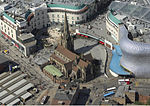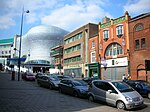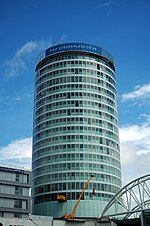St Martin in the Bull Ring
19th-century Church of England church buildingsChurch of England church buildings in Birmingham, West MidlandsChurches completed in 1873Grade II* listed buildings in BirminghamGrade II* listed churches in the West Midlands (county) ... and 4 more
Incomplete lists from August 2008Major Churches NetworkRebuilt churches in the United KingdomUse British English from February 2013

St Martin in the Bull Ring is a Church of England parish church in the city of Birmingham, West Midlands, England. It is the original parish church of Birmingham and stands between the Bull Ring Shopping Centre and the markets. The church is a Grade II* listed building. The current rector is Jeremy Allcock.
Excerpt from the Wikipedia article St Martin in the Bull Ring (License: CC BY-SA 3.0, Authors, Images).St Martin in the Bull Ring
Edgbaston Street, Birmingham Digbeth
Geographical coordinates (GPS) Address External links Nearby Places Show on map
Geographical coordinates (GPS)
| Latitude | Longitude |
|---|---|
| N 52.477 ° | E -1.8932 ° |
Address
St Martins
Edgbaston Street
B5 5BB Birmingham, Digbeth
England, United Kingdom
Open on Google Maps










